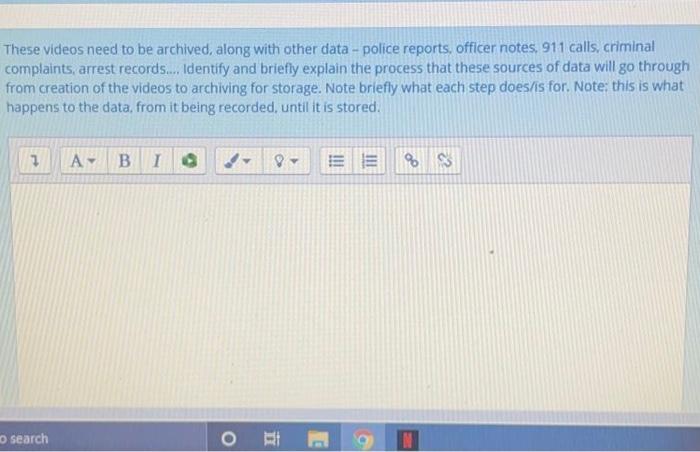Police officers in Edmonton (generally have neither body cameras nor dashcams to document their interactions with the public. You have been hired to consult with the City to implement these cameras and their supporting systems: your CMIS 2250 knowledge is critical in keeping the populace safe. Some major points that need to be addressed are: Each of the cameras will need to store data locally on the device and transfer it to a centralized storage location for archiving . Cameras must be durable enough to handle the day to day life of a cop. e.g. filming while violently detainir someone. The cars have a built in computer with ample available storage, however the body cameras have limited storage and the ability to offload some data in the middle of a shift will allow for higher definition video to captured, which is a definite benefit. Cars are equipped with a mobile data connection, but it is not high bandwidth. The recordings will need to be stored within the police department for at least 7 years. While in storage. these recordings must be secure from unauthorized access but able to be quickly retrieved by time. locatio police report number, officer name, and other relevant descriptors. Note: Bodycams are cameras mounted on one's chest that roughly tape what an officer sees: think of a GoPro on your chest. Dashcams record approximately what you'd see looking out of the front window of a patrol car Please answer the questions below. Bullet points are ok. If you identify a solution please justify why, e.g. If there was a question that asked you how to connect all the devices in your home to the internet a response 'router would be correct but incomplete. A response of a router can connect multiple wired and wireless devices in a LAN, and facilitate all to connect to the internet" would be more suitable. These videos need to be archived, along with other data - police reports, officer notes, 911 calls, criminal complaints, arrest records.... Identify and briefly explain the process that these sources of data will go through from creation of the videos to archiving for storage. Note briefly what each step does/is for. Note: this is what happens to the data from it being recorded, until it is stored. 7 " B 1 E = o search o g








